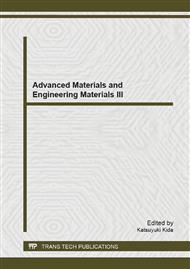[1]
V.A. Kochemirovsky, E.M. Khairullina, S.V. Safonov, L.S. Logunov, I.I. Tumkin and L.G. Menchikov, The influence of non-ionic surfactants on laser-induced copper deposition, Appl. Surf. Sci. 280 (2013) 494-499.
DOI: 10.1016/j.apsusc.2013.05.016
Google Scholar
[2]
V.A. Kochemirovsky, S.V. Safonov, M.K. Strukov, I.I. Tumkin, L.S. Logunov and L.G. Menchikov, Glycerol as a ligand for the laser-induced liquid phase deposition of copper, Glass Phys. Chem. 39(4) (2013) 403-408.
DOI: 10.1134/s1087659613040111
Google Scholar
[3]
A. Manshina, , A. Povolotskiy, T. Ivanova, A. Kurochkin, Y. Tver'yanovich, D. Kim, M. Kim and S.C. Kwon, CuCl2-based liquid electrolyte precursor for laser-induced metal deposition, Laser Phys. Lett. 4 (3) (2007) 242–246.
DOI: 10.1002/lapl.200610093
Google Scholar
[4]
A.A. Man'shina, A.V. Povolotskiy, T.Y. Ivanova, A.V. Kurochkin, Y. S. Tver'yanovich, D. Kim, M. Kim and S. Kwon, Laser-induced copper deposition on the surface of an oxide glass from an electrolyte solution, Glass Phys. Chem. 33 (3) (2007).
DOI: 10.1134/s1087659607030030
Google Scholar
[5]
A.A. Manshina, A.V. Povolotskiy, T.Y. Ivanova, Y.S. Tver'yanovich, S.P. Tunik, D. Kim, M. Kim, and S.C. Kwon, Effect of salt precursor on laser-assisted copper deposition, Appl. Phys. A-Mater. 89 (3) (2007) 755–759.
DOI: 10.1007/s00339-007-4164-9
Google Scholar
[6]
V.A. Kochemirovsky, L.S. Logunov, S.V. Safonov, I. I. Tumkin, Y.S. Tver'yanovich and L.G. Menchikov, Sorbitol as an efficient reducing agent for laser-induced copper deposition, Appl. Surf. Sci. 259 (2012) 55–58.
DOI: 10.1016/j.apsusc.2012.06.085
Google Scholar
[7]
R. Ramanauskas, I. Jurgaitienst and A. Vaskelis, Electrocatalytic oxidation of formaldehyde on copper single crystal electrodes in alkaline solutions, Electrochim. Acta 42 (2) (1997) 191–195.
DOI: 10.1016/0013-4686(96)00143-0
Google Scholar
[8]
M. Z. Luo and R. P. Baldwin, Characterization of carbohydrate oxidation at copper electrodes, J. Electroanal. Chem. 387 (1–2) (1995) 87–94.
Google Scholar
[9]
K. Kordas, J. Bekesi, R. Vajtai, L. Nanai, S. Leppavuouri, A. Uusimaki, K. Bali, T. F. George, G. Galbacs, and F. Ignacz, Laser-assisted metal deposition from liquid-phase precursors on polymers, Appl. Surf. Sci. 172 (2001) 178–189.
DOI: 10.1016/s0169-4332(00)00852-7
Google Scholar
[10]
R. von Gutfeld and K. Sheppard, Electrochemical microfabrication by laser-enhanced photothermal processes, IBM J. Res. Dev. 42 (5) (1998) 639–653.
DOI: 10.1147/rd.425.0639
Google Scholar
[11]
V.A. Kochemirovsky, L.G. Menchikov, A.G. Kuz'min, S.V. Safonov, I.I. Tumkin, and Y.S. Tver'yanovich, Side reactions during laser-induced deposition of copper from aqueous solutions of CuII complexes, Rus. Chem. B+ 61 (5) (2012) 1041-1047.
DOI: 10.1007/s11172-012-0133-3
Google Scholar
[12]
E. Norkus, V. Kepenienė and I. Stalnioniene, Application of environment-friendly ligands for alkaline electroless copper plating systems : A comparative study of electroless copper deposition using D- , L- and DL-tartrate as Cu (II) ligands, Chemija 23 (3) (2012).
DOI: 10.1149/ma2014-01/9/521
Google Scholar
[13]
A. M. Brodsky and Y.V. Pleskov, Electron photoemission at a metal-electrolyte solution interface. Progress in surface science, New York : Pergamon Press, (1972).
DOI: 10.1016/0079-6816(72)90010-x
Google Scholar


